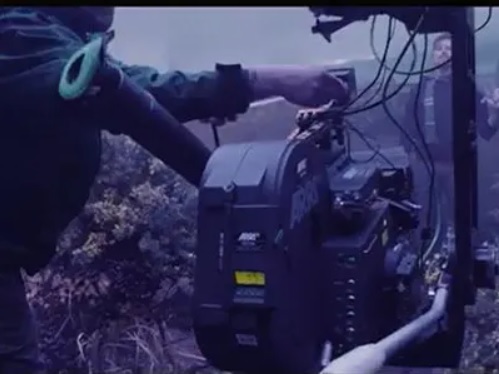Manchester-based virtual production facility Pathway has acheived a world first, shooting 65mm film on a virtual production stage.
Working in partnership with Kodak, Panavision, and Arri Rental, the test sequence was shot on Kodak VISION3 65mm 200T Colour Negative Film stock with an ARRIFLEX 765 on ARRI Rental Vintage 765 lenses.
This is the same camera that was used on films such as Gravity (2013) and Tenet (2020). The virtual production scene was powered by Unreal Engine 5.2, and the whole production was completed in ten days and you can see how it was made below.
The sequence was shot by cinematographer Paul Mortlock GBCT and directed by James Slater, who is known from his music video work with singer-songwriter Sam Fender, singer Jamie T and for recently achieving a Vimeo staff pick for documentary Look For The Diamonds.
The scene is based on the novel Questus by Shawn Williamson, and features character Angus MacWilliam, played by Graham Gardner, who wields a stone sword as he slowly advances through dense Scottish gorse bushes on the edge of Loch Eriboll.
Nathan Newman, co-founder of Pathway, said: “We wanted to see if shooting an LED wall on 65mm could give virtual production more character and presence.”
He added, “It’s not every day that you get to work with such a rare and prestigious camera and we were delighted to onboard such helpful collaborators.
“When we told our would-be collaborators about our plans they didn’t ask ‘why?’ they asked ‘what do you need?’ We couldn’t have made this happen without their kind support and a shared vision to pursue innovation.”
Slater said: “This project was a case of two firsts for me – shooting on a virtual production set and on 65mm. I felt privileged to experience first hand the possibilities this could offer.”
Mortlock commented: “In terms of prep, we were interested to see how the screen would react and work with film. Any artefacts, moiré – any issues like that, we wanted to find out.
“We had half a roll of 35mm film from another project and we shot it at various distances with various lenses, looking for any issues that we might come across. It was a proving ground for what was to come.”
He continued on shooting in a virtual environment: “It was about being able to get those shots that you just can’t get, or it would be too expensive to get, that stand in your way of achieving what you really want to get.
“So that was really interesting, especially when working in Unreal [Engine] where you can
Pathway opened its 6,000 sq ft virtual production facility last year, in partnership with HP, and aims to work on the development and production of in-camera visual effects that utilise real-time technology, as well as offer virtual production training.






